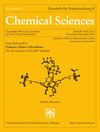Cyclische Diazastannylene. - XXX : Symmetrisch und asymmetrisch substituierte German- und Stannandiyle mit Amid-, Alkoholat- und Thiolat-Liganden. - Teil I
IF 0.8
4区 化学
Q4 CHEMISTRY, INORGANIC & NUCLEAR
Zeitschrift Fur Naturforschung Section B-A Journal of Chemical Sciences
Pub Date : 1989-01-01
DOI:10.22028/D291-22561
引用次数: 1
Abstract
M. V eith*. P. H obein und R. R osier Institut für Anorganische Chemie der Universität des Saarlandes, D-6600 Saarbrücken Z. Naturforsch. 44b, 1067—1081 (1989); eingegangen am 2. März 1989 Syntheses, X-Ray, Symmetrically and Unsymmetrically Substituted Germaneand Stannanediyls, Chelates of G e(II) and Sn(II) Symmetrically and unsymmetrically substituted germaneand stannanediyls as well as che lated bis(amino)or aminooxogermaniumand -tinmonohalides have been obtained from cyclic bis(amino)germaneand stannanediyls by treatment with /m -butylam ine, fm -butanol and rm -butylm ercaptane. The following compounds have been svnthesized; GeX^ (X = OrBu (5), SrBu (6)), Sn(SrBu), (9), GeXCl (X = N(H)rBu (21), Ö/Bu (22)), SnXCl (X = N(H)rBu (23), O/Bu (24), S/Bu (25), OMe (28)) and Sn(OzBu)Br (27). In the series of the chelates Me2Si(NrBu)(NH/Bu)GeCl (13), Me2Si(N?Bu)(OrBu)SnX (X = Cl (18). OMe (19)) and the bischelate [Me2Si(N?Bu)(0/Bu)]2Sn (20) have been prepared. When 18 is allowed to react with aluminiumtrimethyl Me2Si(N;Bu)(OrBu)AlClMe is formed, a compound with a center of chirality at ine aluminium atom. X-ray structure determinations have been performed on single crystals of 6, 8, 9, 13, 22 and 24. 6, 8, 22 and 24 form molecular dimers with c.n. of 3 at the Ge or Sn atoms, resp. While the /Bu —S ligands are syn with respect to the central G e2S2 ring in 6 (symmetry approaching C2v). the fBu — O ligands are anti to the central Sn20 2 ring in 8 (sym metry C|). 9 forms a coordination polymer with all Sn atoms in a i^-trigonal-bipyramidal and all S atoms in a i/'-tetrahedral environment. The germanium atom in 13 is coordinated by a chlorine, a A3and a A4-nitrogen atom , the two nitrogen atoms being connected by as dimethylsilyl group. The hydrogen and chlorine atom of 13 are found at the same side of the four-membered chelate ring. The two unsymmetrically substituted, homologous compounds G e(0/B u)C l (22) and Sn(OrBu)Cl (24) are found to form dimers via O—>Ge resp. O-^Sn bonds. While the chlorine atoms in 22 are syn with respect to the four-membered ring, they are anti in the case of molecule 24.Cyclische Diazastannylene .3x:和数不对称的德国式和斯坦坦代跟混合着阿米德、酒精、道德轿车替换的人是对称的,不对称。一号
v.v eith先生*。P. H . obein und R. R. osier Institut fr anorganche Chemie der Universität des Saarlandes, D-6600 saarbr cken Z. Naturforsch. 44b, 1067-1081 (1989);2岁。März 1989合成,x射线,对称和不对称取代的锗和锡二基,G (II)和Sn(II)的螯合物。用/m -丁基胺,正丁醇和正丁基正丁烷处理,得到了对称和不对称取代的锗和锡二基以及与其相关的双(氨基)或氨基锗和锡单卤化物。以下化合物已被合成:GeX ^ (X = OrBu (5), SrBu (6)), Sn (SrBu)、(9)、GeXCl (X = N (H) rBu (21), O /部(22),SnXCl (X = N (H) rBu (23), O /部(24),S /部(25),渗出性中耳炎(28)和Sn OzBu Br(27)。在一系列的螯合物中,Me2Si(NrBu)(nhh /Bu)GeCl (13), Me2Si(N?Bu)(OrBu)SnX (X = Cl(18))。制备了双螯合物[Me2Si(N?Bu)(0/Bu)]2Sn(20)。当18与铝三甲基Me2Si(N;Bu)(OrBu)反应时,生成手性中心在铝原子上的化合物AlClMe。对6、8、9、13、22和24号单晶进行了x射线结构测定。6、8、22和24在Ge或Sn原子处形成c.n为3的分子二聚体。而/Bu -S配体相对于6中的中央ge2s2环是同步的(对称性接近C2v)。fBu - O配体在8(对称c|)中与中心Sn20环相反。9与所有Sn原子在i^-三角双锥体环境中形成配位聚合物,所有S原子在i/'-四面体环境中形成配位聚合物。13中的锗原子由一个氯、一个a3和一个a4氮原子配位,两个氮原子由一个二甲基硅基连接。13的氢原子和氯原子位于四元螯合环的同一侧。两个不对称取代的同源化合物Ge (0/B u)Cl(22)和Sn(OrBu)Cl(24)通过O - >Ge反应形成二聚体。O - ^ Sn债券。虽然22号分子中的氯原子相对于四元环是正的,但在24号分子中它们是反的。
本文章由计算机程序翻译,如有差异,请以英文原文为准。
求助全文
约1分钟内获得全文
求助全文
来源期刊
CiteScore
1.80
自引率
12.50%
发文量
91
期刊介绍:
Zeitschrift fuer Naturforschung B (ZNB) publishes novel research in all areas of inorganic chemistry, organic chemistry, and analytical chemistry. In particular, the journal focuses on solid state chemistry, coordination chemistry, main group element chemistry, synthetic organic chemistry, natural product chemistry and, to a lesser extent, on analytical chemistry. For more than 65 years Zeitschrift fuer Naturforschung B has been open to contributions from all fields of experimental and theoretical chemistry. Zeitschrift fuer Naturforschung B publishes 12 issues per volume/year. Sometimes double issues occur.
Topics
Solid state chemistry
Coordination chemistry
Main group element chemistry
Organic chemistry
Natural product chemistry.

 求助内容:
求助内容: 应助结果提醒方式:
应助结果提醒方式:


